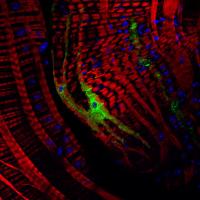
Insect muscle cells are marked in red, cell nuclei (DNA) in blue and virus in green. Insects can transmit viral diseases to humans. Therefore, understanding how insects cope with viral infection, and what immune mechanisms are triggered, can be important to stop diseases transmission. In a study published in this week's issue of the scientific journal PLOS Pathogens*, researchers from the Instituto Gulbenkian de Ciencia (IGC; Portugal) now show that the entry route of the virus changes how the insect host responds to it. Using the fruit flies as a model of study, they discovered an immune mechanism that is specifically effective when flies are infected through feeding.
Dengue, yellow fever and chikungunya are diseases caused by viruses that are transmitted to humans via mosquitoes. However, for the transmission to occur it is necessary that the virus completes an infection cycle so that the insect becomes infected. This may take up to several days after the entry of the virus into the host, which is why it becomes so important to study viral infection in insects.
Until now two main antiviral defense mechanisms of fruit flies were known. One of these mechanisms acts by interfering with the reading of the viral genes or its genome, blocking its replication within the host; the other, is a protective mechanism conferred by bacteria living inside cells of the host. However, the studies leading to the identification of these mechanisms were conducted in a set up that did not explore different entry routes in the host. The fruit fly (Drosophila melanogaster), used as a model organism to study immunity in insects, is normally infected by injection, which might mimic the bites of mites that occur in nature. However, this mode of infection might not recapitulate well natural oral infections that occur when insects eat contaminated food, as when mosquitoes feed on blood of infected humans. Luis Teixeira's team, at the IGC, set up to investigate if there could be differences when viruses used different entry routes to infect flies.
Álvaro Gil Ferreira, investigator in Teixeira's laboratory and first author of this study, discovered that when flies were fed with food containing virus they would require an immune mechanism that had been described only to be activated for infections caused by bacteria or fungi, the so called Toll pathway. He reached this conclusion by studying mutants of flies that lacked proteins involved in this mechanism. Álvaro Gil Ferreira observed that these mutant flies survived less to viral infection than the normal flies, which indicated that those proteins of the Toll pathway were playing a role in the defense against viral infection.
Then, the research team went on to investigate if this same mechanism was also required when flies were infected through an injection in the thorax. They observed no differences between the survival of mutant flies and the normal flies after viral infection, indicating that the proteins of the Toll pathway were not playing a significant defensive role in this setup. The researchers observed that the same tissues of the fly were being infected independently of the entry route of the virus, but the infection spread faster when flies were injected with virus. The reason for this might be the fact that the injection in the thorax leads to a widespread systemic infection, since the viral particles can reach faster many tissues of the fly, through the fluid in the fly body cavity (the hemolymph, a fluid similar to the blood). When the virus enters the host through feeding, the researchers observed that in the first days of the infection the viral particles are confined to a specific tissue.
Luis Teixeira says: "This work shows how dramatically the response to viral infection changes with the way the viruses enter the organism. It also demonstrates how the mechanisms involved in the response to natural routes of infection may be more complex than the infection response with the protocol normally used in the laboratory."
Álvaro Gil Ferreira adds: "We showed that this mechanism is blocking several viruses that infect the fruit flies. By comprehending the details of the mechanisms of insects involved in the defense against viruses we may find targets to block human diseases transmitted by insects."
Knowing better the host's responses upon viral infection by different routes might also help to explain some biological phenomena observed in nature. For example, the survival of honeybees contaminated with virus seems to depend on the entry route of the virus. If contaminated through bites of mites, the honeybees die, whereas if they receive the virus from their progenitors, they can live.
Source: Instituto Gulbenkian de Ciencia
 Print Article
Print Article Mail to a Friend
Mail to a Friend
